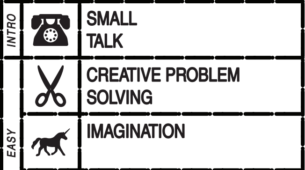Nobody really knows the true origins of Blackjack, a popular card game available today at most casinos. However, it is generally agreed that the game probably originated around the year 1700 in the French casinos. Blackjack is always played with standard 52-card decks (often more than one), though my table had some fun and played with a giant deck of cards. Playing with these giant cards did nothing to change the game other than adding a bit of humor.

Blackjack is a game of chance, and its target audience is pretty much any human on the planet old enough to understand the rules. However, if you asked a casino, they’d probably have to tell you the game is 21+ because that is the minimum age to enter a casino. Groups of 2-7 can play at a time, along with a dealer representing the house who also controls the flow of the game.
Like other card games, Blackjack has been around in casinos for a long time, and that’s not by accident. Blackjack employs textbook addictive design patterns, including an illusion of control and obscured odds, to help casinos entice and profit from players. These design patterns keep the player engaged for longer, increasing their likelihood of losing money.
The illusion of control is an important aspect of Blackjack. While the outcome of a game of Blackjack is almost entirely up to chance, players certainly have opportunities to influence the flow of the game. The primary action players can take is the choice between “Hitting” or “Staying” on their turn. If the player thinks the next card in the deck will not cause their hand to go over 21, they can “Hit” and add that next card to their deck. If they don’t want any more cards, they can “Stand.” Beyond these standard actions, Blackjack gives players several other levers to pull during the game, choices that give the player some extra sense of control. The most interesting of these actions, I feel, is “Splitting Pairs,” where the player is allowed to split their original hand into two hands if the original hand contained two cards of the same denomination (e.g., a pair of fives).
The presence of these actions gives the player the false hope of developing some strategy that can beat the game. All the way back when we learned about what games are and aren’t, we learned that learning, mastering, and winning are the drugs that make games fun. A player could be drawn back into the game again and again, thinking they saw something that hinted at a strategy to win, trying to learn the patterns of the game when, in reality, everything that is happening is just by chance. The pure randomness makes games like Blackjack a lot like “Skinner boxes,” in that the same starting hand and the same actions can lead to different outcomes in different games. Sometimes, choosing to split your pair is the reason you won, and sometimes it is the reason you lost. However, neither outcome was due to strategy, and randomness keeps you coming back for more.
Another aspect of Blackjack related to the illusion of control is the game’s odds. The illusion of control is an illusion because players might think there is a way to beat the game. If only we knew the optimal strategy to maximize your expected winnings despite the game’s randomness! As it turns out, such a strategy is widely known and available online for all to use. It’s called the “basic strategy,” and it tells you exactly what choices to make in every scenario to minimize the “house edge” or otherwise maximize the expected return for the player. The basic strategy does not involve card counting or any other prohibited advantages; it is simply the best decision a player can make at each turn to maximize their chances of winning.
Unfortunately, even this optimal strategy can’t beat the house. Even under the basic strategy, Blackjack has a negative expected value for the player, meaning that after enough games, you will eventually lose more than you win. What’s more, this slight advantage towards the house only reveals itself in the long run; with around a 42% chance of winning a hand, you’ll probably win a few times while sitting at the table. It’s easy not to realize that the house is winning just a little more often than you are.
Due to the house edge, it is crucial from the casino’s perspective that you keep playing: the longer you play, the more likely you are to start losing money. Part of what makes Blackjack so good for casinos is that it inherently obscures the game’s odds. Similar to how slots use virtual reel mapping to map a large number of game states to just a few reel faces, Blackjack creates a sense of smallness due to how few cards are in play at a time. Your hand starts out with just two cards, and a relatively small percentage of the deck gets used in each game. As a player, you see two cards and know that there are only so many combinations of cards you could get.

After a couple of rounds, you know you’re bound to get one of those “good hands” that have a higher likelihood of turning into a win than the others. Those are the hands you should double down on, right? Those are the hands you’re hoping for when you play just one more time, right? What players may not be consciously aware of is that a good hand is still not always a winning hand. The number of possible states of Blackjack is in the billions (the math changes depending on how you define states), and plenty of losing states start out with the same “good hand” you thought would win. Keeping the player from thinking about those odds is key to enticing them into the game. In the Addiction by Design reading, a quote by a Nevada gaming regulator puts it like so: “purposive obfuscation is key to the seductive appeal of gambling machines.” Even though the obfuscation in slot machines is more obvious (players often do not have access to information about the machine’s odds), I argue that a seductive appeal also results from the more subtle obfuscation by design that appears in Blackjack.
I’ll close with a bit on ethics and design suggestions. As previously stated, Blackjack has a negative expected value, meaning players who play for a long time are more likely to lose their money. If they played with the basic strategy, those losses would be minimized in expectation, but many players don’t know the basic strategy or have access to it during the game. Playing with a suboptimal strategy could result in more significant losses, and some players can’t afford to lose that much. What if casinos offered Blackjack tables that told the player what the basic strategy was, so they always knew how to play optimally? Tables like these would be less profitable, but they would still make money in the long run due to the house edge. To compensate, the casino could either increase the house edge or set the bet at these tables to be a low amount. A low bet would also provide a nice training ground for new players to try Blackjack without risking too much money.
Blackjack is a game with deceivingly simple mechanics and cleverly addictive design patterns that lure players in and keep them playing. While not as optimized for addiction as slot machines, its design similarly accomplishes many of the goals behind slot machine technology. Just as those machines are scrutinized for their mechanics, so should other games of chance like Blackjack. Even if the rules and odds of Blackjack are more transparent, they are designed in a way that pulls the player’s focus away from the negative expected value and pure randomness and towards the illusion of control. I wouldn’t say games are chance like Blackjack should be banned; it is up to the player to decide whether they want to risk their money or not. However, I think the games become less permissible when they are designed to manipulate the player into losing more. The gaming industry should continue to regulate these games in a way that allows casinos to be profitable without preying too egregiously on their patrons.


